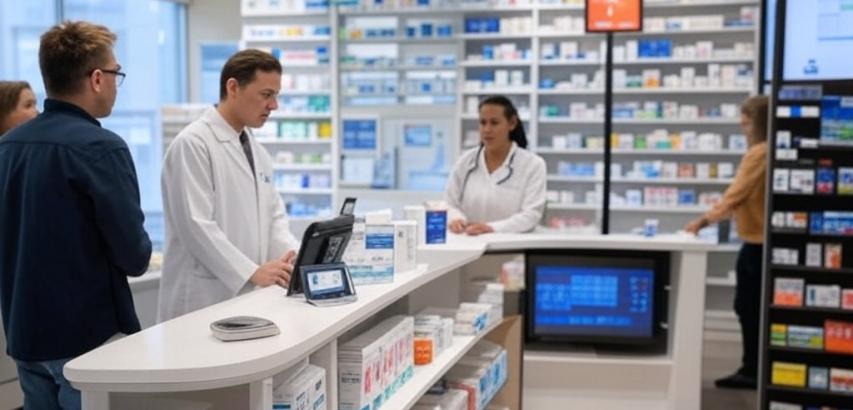Executive Summary
The Smart Pharmacy Project aims to revolutionize the traditional pharmacy model by integrating advanced technologies such as artificial intelligence (AI), Internet of Things (IoT), and data analytics to enhance customer experience, improve operational efficiency, and ensure better health outcomes. This innovative pharmacy will offer personalized medication management, automated prescription refills, real-time health monitoring, and seamless integration with healthcare providers. The goal is to create a smarter, more efficient, and customer-centric pharmacy that meets the evolving needs of modern healthcare consumers.
Business Objectives
Enhance Customer Experience: Provide personalized and convenient services through digital platforms.
Improve Medication Adherence: Use AI and IoT to remind patients to take medications and track their usage.
Streamline Operations: Automate inventory management, prescription refills, and order processing.
Integrate with Healthcare Ecosystem: Collaborate with doctors, hospitals, and insurance providers for seamless healthcare delivery.
Ensure Data Security: Protect patient data with robust cybersecurity measures.
Market Analysis
Industry Overview:
The global pharmacy market is growing rapidly, driven by increasing healthcare needs, aging populations, and the rise of chronic diseases. The integration of technology in healthcare is creating opportunities for innovative solutions like the Smart Pharmacy.
Target Market:
Tech-savvy individuals seeking convenience.
Patients with chronic conditions requiring regular medication.
Elderly patients who need assistance with medication management.
Healthcare providers looking for efficient patient care solutions.
Competitive Analysis:
Traditional pharmacies lack technological integration.
Emerging competitors include online pharmacies and health tech startups.
Differentiation through personalized services, AI-driven insights, and IoT integration.
Services and Features
Smart Prescription Management:
Digital prescriptions with automatic refills.
AI-based medication reminders and tracking.
Health Monitoring:
IoT-enabled devices to monitor vital signs (e.g., blood pressure, glucose levels).
Integration with wearable health devices.
Telehealth Integration:
Virtual consultations with pharmacists and doctors.
Real-time communication with healthcare providers.
Inventory Management:
Automated stock tracking and replenishment.
Predictive analytics to anticipate demand.
Customer App:
Mobile app for prescription management, health tracking, and telehealth services.
Personalized health recommendations based on data analytics.
Revenue Model
Product Sales:
Revenue from over-the-counter (OTC) medications and health products.
Subscription Services:
Monthly or annual fees for premium features like personalized health insights and advanced monitoring.
Partnerships:
Collaborations with healthcare providers, insurance companies, and pharmaceutical manufacturers.
Data Analytics Services:
Selling anonymized health data and insights to research institutions and healthcare organizations (with customer consent).
Marketing Strategy
Digital Marketing:
Social media campaigns, search engine optimization (SEO), and targeted ads to reach tech-savvy customers.
Partnerships:
Collaborate with hospitals, clinics, and insurance providers to promote the Smart Pharmacy.
Community Engagement:
Host health workshops, webinars, and awareness campaigns to educate the public about the benefits of smart pharmacy services.
Referral Programs:
Incentivize existing customers to refer friends and family.
Operational Plan
Technology Infrastructure:
Develop a robust platform integrating AI, IoT, and data analytics.
Ensure compliance with healthcare regulations (e.g., HIPAA, GDPR).
Staffing:
Hire licensed pharmacists, IT specialists, and customer support staff.
Train employees on using smart pharmacy technologies.
Supply Chain Management:
Partner with reliable suppliers for medications and health products.
Implement automated inventory management systems.
Customer Support:
Provide 24/7 support through chatbots, phone, and email.
Financial Plan
Startup Costs:
Technology development: ~500,000
Inventory and equipment: ~200,000
Marketing and branding: ~100,000
Operational expenses (first 6 months): ~150,000
Total initial investment: ~950,000
Revenue Projections:
Year 1: ~1.2 million
Year 2: ~2.5 million
Year 3: ~4 million
Funding Requirements:
Seeking ~1 million in seed funding to cover startup costs and initial operations.
Potential sources: Venture capital, angel investors, or healthcare grants.
Break-Even Analysis:
Expected to break even within 18 months of operation.
Risk Analysis
Regulatory Compliance:
Ensure adherence to healthcare and data privacy regulations.
Technology Risks:
Potential system failures or cybersecurity breaches.
Mitigation: Implement robust security measures and regular system audits.
Market Competition:
Differentiate through superior technology and customer service.
Customer Adoption:
Educate customers on the benefits of smart pharmacy services to drive adoption.
The Smart Pharmacy Project is poised to disrupt the traditional pharmacy model by leveraging cutting-edge technology to deliver personalized, efficient, and secure healthcare services. With a strong value proposition, a clear revenue model, and a focus on customer satisfaction, this project has the potential to become a leader in the evolving healthcare landscape. By addressing the challenges and capitalizing on the opportunities, the Smart Pharmacy will create lasting value for customers, partners, and stakeholders.
Next Steps
Finalize funding and partnerships.
Develop and test the technology platform.
Launch pilot programs in select locations.
Scale operations based on feedback and performance.
This business plan provides a roadmap for the successful launch and growth of the Smart Pharmacy Project.
 |  |  |
